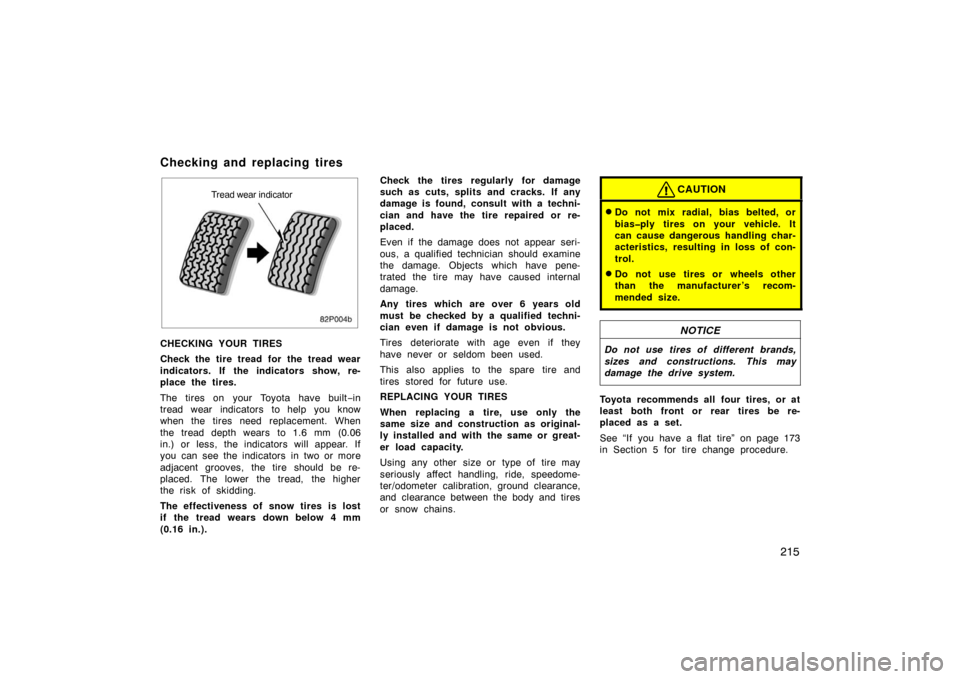Page 209 of 258

196
INSIDE THE VEHICLE
Items listed below should be checked
regularly, e.g. while performing periodic
services, cleaning the vehicle, etc.
Lights
Make sure the headlights, stop lights, tail
lights, turn signal lights, and other lights
are all working. Check headlight aim.
Service reminder indicators and warning
buzzers
Check that all service reminder indicators
and warning buzzers function properly.
Steering wheel
Be alert for changes in steering condition,
such as hard steering or strange noise.
Seats
Check that all front seat controls such as
seat adjusters, seatback recliner, etc. op-
erate smoothly and that all latches lock
securely in any position. Check that the
head restraint move up and down smooth-
ly and that the locks hold securely in any
latched position. For folding−down rear
seatbacks, check that the latches lock se-
curely. Seat belts
Check that the seat belt system such as
buckles, retractors and anchors operate
properly and smoothly. Make sure the belt
webbing is not cut, frayed, worn or dam-
aged.
Accelerator pedal
Check the pedal for smooth operation and
uneven pedal effort or catching.
Brake pedal
Check the pedal for smooth operation and
that the pedal has the proper clearance.
Check the brake booster function.
Brakes
At a safe place, check that the brakes do
not pull to one side when applied.
Parking brake
Check that the pedal has the proper travel
and that, on a safe incline, your vehicle
is held securely with only the parking
brake applied.
Hybrid transaxle ”Park” mechanism
Check the lock release button of the se-
lector lever for proper and smooth opera-
tion. On a safe incline, check that your
vehicle is held securely with the selector
lever in ”P” position and all brakes re-
leased.
IN THE ENGINE COMPARTMENT
Items listed below should be checked
from time to time, e.g. each time when
refueling.
Washer fluid
Make sure there is sufficient fluid in the
tank. See page 225 in Section 8
−3 for
additional information.
Coolant level
Make sure the coolant level is between
the ”FULL” and ”LOW” lines on the see −
through reservoir when the hybrid system
is cold. See page 210 in Section 8 −2 for
additional information.
Radiator, condenser and hoses
Check that the front of the radiator and
condenser are clean and not blocked with
leaves, dirt, or insects. See page 211 in
Section 8 −2 for additional information.
Page 215 of 258

202
If you perform maintenance by yourself,
be sure to follow the correct procedure
given in this Section.
You should be aware that improper or in-
complete servicing may result in operating
problems.
Performing do−it−yourself maintenance
during the warranty period may affect your
warranty coverage. Read the separate
Toyota Warranty statement for details and
suggestions.
This Section gives instructions only for
those items that are relatively easy for an
owner to perform. As explained in Section
7, there are still a number of items that
must be done by a qualified technician
with special tools.
For information on tools and parts for do −
it −yourself maintenance, see ”Parts and
tools” on page 205 in this Section.
Utmost care should be taken when work-
ing on your vehicle to prevent accidental
injury. Here are a few precautions that
you should be especially careful to ob-
serve:CAUTION
�When the hybrid system is on, keep
hands, clothing, and tools away
from the moving fan and engine
drive belts. (Removing rings,
watches, and ties is advisable.)
�Right after driving, the engine
compartment—the engine, radiator,
exhaust manifold and spark plug
boots, etc.—will be hot. So be care-
ful not to touch them. Oil, fluids
and spark plugs may also be hot.
�If the hybrid system is hot, do not
remove the radiator cap or loosen
the drain plugs to prevent burning
yourself.
�Do not smoke, cause sparks or al-
low open flames around fuel or the
batteries. Their fumes are flam-
mable.
�When the hybrid system is operat-
ing with the “READY” light on, the
engine is automatically started in
some case. When you inspect the
engine compartment, be sure to
turn the ignition switch to “OFF”
position.
�Do not get under your vehicle with
just the body jack supporting it. Al-
ways use automotive jack stands or
other solid supports.
�Be sure that the ignition is off if
you work near the electric cooling
fans or radiator grille. With the
ignition on, the electric cooling fans
will automatically start to run if the
engine coolant temperature is high
and/or the air conditioning is on.
�Use eye protection whenever you
work on or under your vehicle
where you may be exposed to fly-
ing or falling material, fluid spray,
etc.
�Be extremely cautious when work-
ing on the batteries. It contains poi-
sonous and corrosive sulfuric acid
or strong alkali.
�Warning: Battery posts, terminals and
related accessories contain lead and
lead compounds, chemicals known to
the State of California to cause can-
cer and reproductive harm. Wash
hands after handling.
Do�it�yourself service
precautions
Page 228 of 258

215
82p004b
Tread wear indicator
CHECKING YOUR TIRES
Check the tire tread for the tread wear
indicators. If the indicators show, re-
place the tires.
The tires on your Toyota have built −in
tread wear indicators to help you know
when the tires need replacement. When
the tread depth wears to 1.6 mm (0.06
in.) or less, the indicators will appear. If
you can see the indicators in two or more
adjacent grooves, the tire should be re-
placed. The lower the tread, the higher
the risk of skidding.
The effectiveness of snow tires is lost
if the tread wears down below 4 mm
(0.16 in.). Check the tires regularly for damage
such as cuts, splits and cracks. If any
damage is found, consult with a techni-
cian and have the tire repaired or re-
placed.
Even if the damage does not appear seri-
ous, a qualified technician should examine
the damage. Objects which have pene-
trated the tire may have caused internal
damage.
Any tires which are over 6 years old
must be checked by a qualified techni-
cian even if damage is not obvious.
Tires deteriorate with age even if they
have never or seldom been used.
This also applies to the spare tire and
tires stored for future use.
REPLACING YOUR TIRES
When replacing a tire, use only the
same size and construction as original-
ly installed and with the same or great-
er load capacity.
Using any other size or type of tire may
seriously affect handling, ride, speedome-
ter/odometer calibration, ground clearance,
and clearance between the body and tires
or snow chains.
CAUTION
�Do not mix radial, bias belted, or
bias�ply tires on your vehicle. It
can cause dangerous handling char-
acteristics, resulting in loss of con-
trol.
�Do not use tires or wheels other
than the manufacturer ’s recom-
mended size.
NOTICE
Do not use tires of different brands,
sizes and constructions. This may
damage the drive system.
Toyota recommends all four tires, or at
least both front or rear tires be re-
placed as a set.
See “If you have a flat tire” on page 173
in Section 5 for tire change procedure.
Checking and replacing tires
Page 252 of 258

239
21. HTR 10 A: Air conditioning system
22. TAIL 7.5 A: Parking lights, tail lights,
license plate lights, side marker lights
23. ECU�IG 5 A: Air conditioning system,
anti −lock brake system, electric power
steering, daytime running light system
24. STOP 15 A: Stop lights, high mounted
stoplights, anti −lock brake system
25. ACC 10 A: Anti−lock brake system
warning light, clock, audio system, mul-
ti −information display, shift lock system
26. WIPER 30 A: Windshield wiper
27. ECU�B 7.5 A: Air conditioning system,
daytime running light system, electric
power steering system, hybrid vehicle
immobiliser system
28. CIG 15 A: Power outlet
29. WASHER 15 A: Washer
30. DOOR 30 A: Power door lock system
31. SRS ACC 10 A: SRS airbags, seat
belt pretensioners
32. OBD II 7.5 A: No circuit
33. PWR1 20 A: Power window system
34. AM1 5 A: “ACC”, “CIG”, “SRS ACC”,
“WASHER”, “HTR”, “WIPER”, “ECU −IG”
and “GAUGE” fuses
35. DC/DC�S 5 A: Inverter and converter 36. HTR NO.3 50 A:
Air conditioning sys-
tem
37. EMPS 50 A: Electric power steering
38. ABS NO.1 40 A: Anti−lock brake sys-
tem
39. MF HEAD 30 A: Daytime running light
system
40. HTR 50 A: Air conditioning system
41. RDI 30 A: Electric cooling fan
42. ABS NO.2 30 A: Hydraulic brake
booster